Dual-Band Large-Frequency Ratio Power Divider Using Mode Composite Transmission Line for 5G Communication Systems
Abstract
1. Introduction
2. Principle of Hybrid SSPPs and CSIW Structure
2.1. The Transition from SIW to CSIW
2.2. Dispersion Analysis of SSPPs
3. MC-TL Design
4. Simulation and Measurement of MC-TL
5. Dual-Band Power Divider Based on MC-TL
6. Conclusions
Author Contributions
Funding
Data Availability Statement
Conflicts of Interest
References
- Halak, B.; El-Hajjar, M.; Toma, O.H.; Cheng, Z. Energy-Efficient Hardware Implementation of an LR-Aided K-Best MIMO Decoder for 5G Networks. J. Low Power Electron. Appl. 2016, 6, 12. [Google Scholar] [CrossRef]
- Pi, Z.; Khan, F. An introduction to millimeter-wave mobile broad-band systems. IEEE Commun. Mag. 2011, 49, 101–107. [Google Scholar] [CrossRef]
- Siddiqui, M.F.; Maheshwari, M.K.; Raza, M.; Masud, A.R. Design and Optimization of an Ultra-Low-Power Cross-Coupled LC VCO with a DFF Frequency Divider for 2.4 GHz RF Receivers Using 65 nm CMOS Technology. J. Low Power Electron. Appl. 2023, 13, 54. [Google Scholar] [CrossRef]
- Nguyen, X.V.L.; Gerges, T.; Bevilacqua, P.; Duchamp, J.-M.; Benech, P.; Verdier, J.; Lombard, P.; Linge, P.U.; Mieyeville, F.; Cabrera, M.; et al. Radio-Frequency Energy Harvesting Using Rapid 3D Plastronics Protoyping Approach: A Case Study. J. Low Power Electron. Appl. 2023, 13, 19. [Google Scholar] [CrossRef]
- Guo, J.; Djerafi, T.; Wu, K. Mode composite waveguide. IEEE Trans. Microw. Theory Tech. 2016, 64, 3187–3197. [Google Scholar] [CrossRef]
- Li, Y.; Wang, J. Dual-band leaky-wave antenna based on dual-mode composite microstrip line for microwave and millimeter-wave applications. IEEE Trans. Antennas Propag. 2018, 66, 1660–1667. [Google Scholar] [CrossRef]
- Xiang, B.J.; Zheng, S.Y.; Wong, H.; Pan, Y.M.; Wang, K.X.; Xia, M.H. A Flexible Dual-Band Antenna with Large Frequency Ratio and Different Radiation Properties over the Two Bands. IEEE Trans. Antennas Propag. 2018, 66, 657–667. [Google Scholar] [CrossRef]
- Su, Y.; Lin, X.Q.; Yu, J.W.; Fan, Y. Mode composite coplanar waveguide. IEEE Access 2019, 7, 109278–109288. [Google Scholar] [CrossRef]
- Wu, K.; Deslandes, D.; Cassivi, Y. The substrate integrated circuits—A new concept for high-frequency electronics and optoelectronics. In Proceedings of the 6th International Conference on Telecommunications in Modern Satellite, Cable and Broadcasting Service (TELSIKS), Nis, Yugoslavia, 1–4 October 2003; Volume 1, pp. P-III–P-X. [Google Scholar]
- Heidari, H.R.; Rezaei, P.; Kiani, S.; Taherinezhad, M. A monopulse array antenna based on SIW with circular polarization for using in tracking systems. AEU-Int. J. Electron. Commun. 2023, 162, 154563. [Google Scholar] [CrossRef]
- Kumar, L.; Nath, V.; Reddy, B.V.R. A wideband substrate integrated waveguide (SIW) antenna using shorted vias for 5G communications. AEU-Int. J. Electron. Commun. 2023, 171, 154879. [Google Scholar] [CrossRef]
- Abdolhamidi, M.; Shahabadi, M. X-band substrate integrated waveguide amplifier. IEEE Microw. Wirel. Compon. Lett. 2008, 18, 815–817. [Google Scholar] [CrossRef]
- Anand, S.; Theetharappan, R. Metamaterial and SIW inspired isolating fences for lateral de-coupling in MIMO antenna. AEU-Int. J. Electron. Commun. 2023, 166, 154667. [Google Scholar] [CrossRef]
- Pendry, J.B.; Martín-Moreno, L.; Garcia-Vidal, F.J. Mimicking surface plasmons with structured surfaces. Science 2004, 305, 847–848. [Google Scholar] [CrossRef] [PubMed]
- Shen, X.; Cui, T.J.; Martin-Cano, D.F.; Garcia-Vidal, J. Conformal surface plasmons propagating on ultrathin and flexible films. Proc. Nat. Acad. Sci. USA 2013, 110, 40–45. [Google Scholar] [CrossRef] [PubMed]
- Ge, S.; Zhang, Q.; Chiu, C.-Y.; Chen, Y.; Murch, R.D. Single-side-scanning surface waveguide leaky-wave antenna using spoof surface plasmon excitation. IEEE Access 2018, 6, 66020–66029. [Google Scholar] [CrossRef]
- Kianinejad, A.; Chen, Z.N.; Qiu, C.-W. Design and modeling of spoof surface plasmon modes-based microwave slow-wave transmission line. IEEE Trans. Microw. Theory Tech. 2015, 63, 1817–1825. [Google Scholar] [CrossRef]
- Pan, B.C.; Cui, T.J. Broadband decoupling Network for Dual-Band Microstrip Patch Antennas. IEEE Trans. Antennas Propag. 2017, 65, 5595–5598. [Google Scholar] [CrossRef]
- Guan, D.-F.; You, P.; Zhang, Q.; Xiao, K.; Yong, S.-W. Hybrid Spoof Surface Plasmon Polariton and Substrate Integrated Waveguide Transmission Line and Its Application in Filter. IEEE Trans. Microw. Theory Tech. 2017, 65, 4925–4932. [Google Scholar] [CrossRef]
- Shen, S.; Xue, B.; Yu, M.; Xu, J. Integrated Mode Composite Transmission Line. IEEE Access 2019, 7, 41479–41491. [Google Scholar] [CrossRef]
- Ye, L.; Chen, Y.; Da Xu, K.; Li, W.; Liu, Q.H.; Zhang, Y. Substrate Integrated Plasmonic Waveguide for Microwave Bandpass Filter Applications. IEEE Access 2019, 7, 75957–75964. [Google Scholar] [CrossRef]
- Chen, D.G.; Eccleston, K.W. Substrate integrated waveguide with corrugated wall. In Proceedings of the 2008 Asia-Pacific Microwave Conference, Macau, China, 16–20 December 2008; pp. 1–4. [Google Scholar] [CrossRef]
- Salehi, M.; Mehrshahi, E. A closed-form formula for dispersion characteristics of fundamental SIW mode. IEEE Microw. Wirel. Compon. Lett. 2011, 22, 4–6. [Google Scholar] [CrossRef]
- Talebi, N.; Shahabadi, M. Spoof surface plasmons propagating alonga periodically corrugated coaxial waveguide. J. Phys. D Appl. Phys. 2010, 43, 35302. [Google Scholar] [CrossRef]
- Wilkinson, E. An N-way hybrid power divider. IRE Trans. Microw. Theory Tech. 1960, MTT-8, 116–11118. [Google Scholar]
- Nguyen, M.G.; Nguyen, C.T.N.; Nguyen, T.H.; Morishita, H. Design of a Dual-Band Three-Way Power Divider with Unequally High Power Split Ratio. Radioengineering 2023, 32, 339. [Google Scholar] [CrossRef]
- Zhao, X.B.; Wei, F.; Zhang, P.F.; Shi, X.W. Mixed-Mode Magic-Ts and Their Applications on the Designs of Dual-Band Balanced Out-of-Phase Filtering Power Dividers. IEEE Trans. Microw. Theory Tech. 2023, 71, 3896–3905. [Google Scholar] [CrossRef]
- Salimi, P.; Jahromi, M.K.; Hossein, A.K.A. A Novel Design Method for Unequal Coupled Line Dual-Band Wilkinson Power Divider. Prog. Electromagn. Res. C 2023, 138, 175–189. [Google Scholar] [CrossRef]
- Danaeian, M. Novel single-layer dual-band half-mode substrate integrated waveguide filter and filtering power dividers with very compact sizes. Int. J. RF Microw. Comput.-Aided Eng. 2022, 32, e22951. [Google Scholar] [CrossRef]
- Mohra, A.S.S. Compact dual band Wilkinson power divider. Microw. Opt. Technol. Lett. 2008, 50, 1678–1682. [Google Scholar] [CrossRef]
- Liao, M.; Wu, Y.; Liu, Y.; Gao, J. Impedance-transforming dual-band out-of-phase power divider. IEEE Microw. Wirel. Compon. Lett. 2014, 24, 524–526. [Google Scholar] [CrossRef]



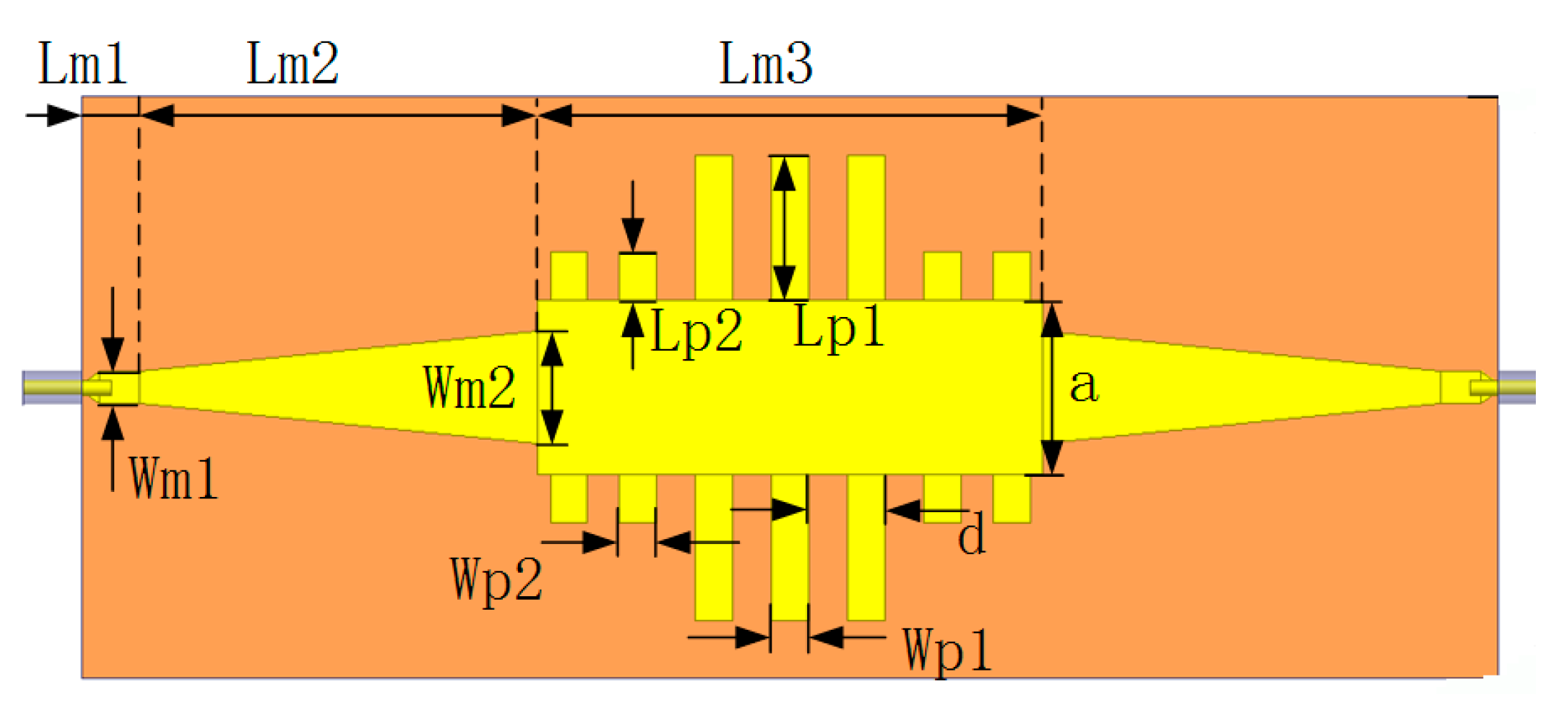


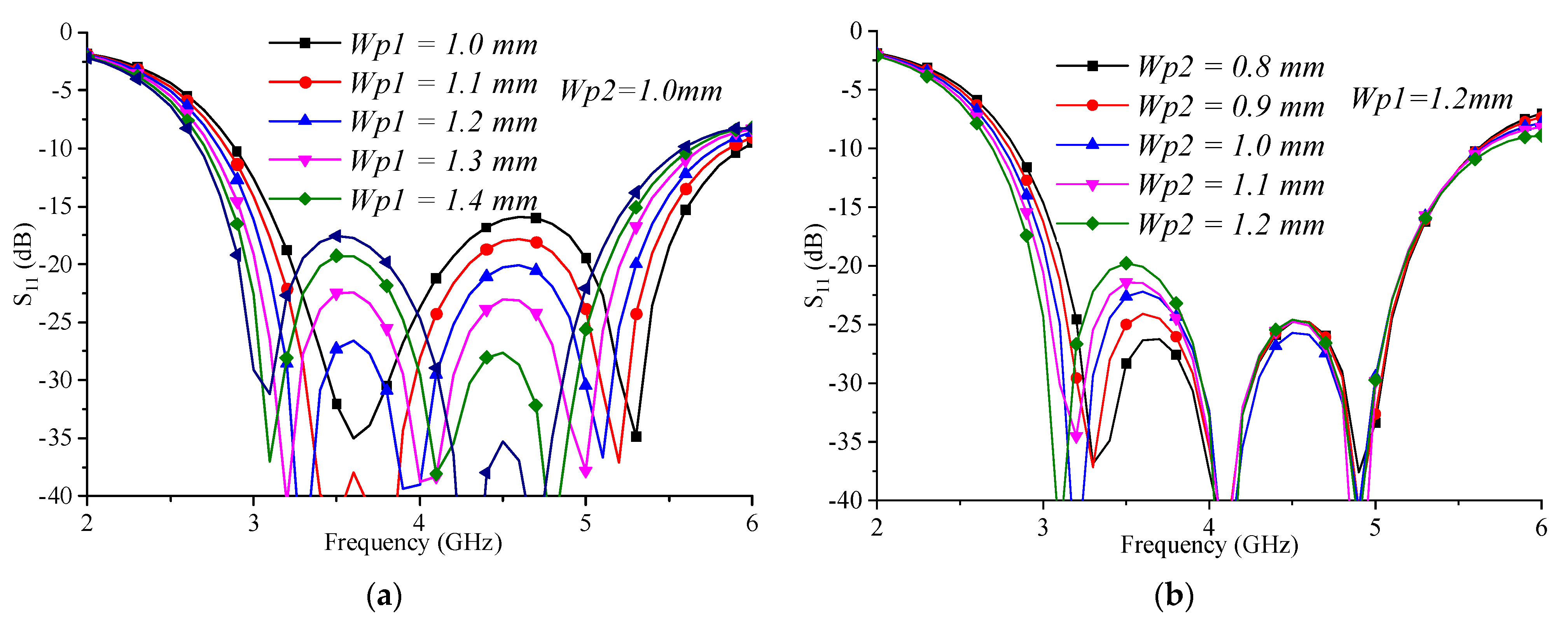
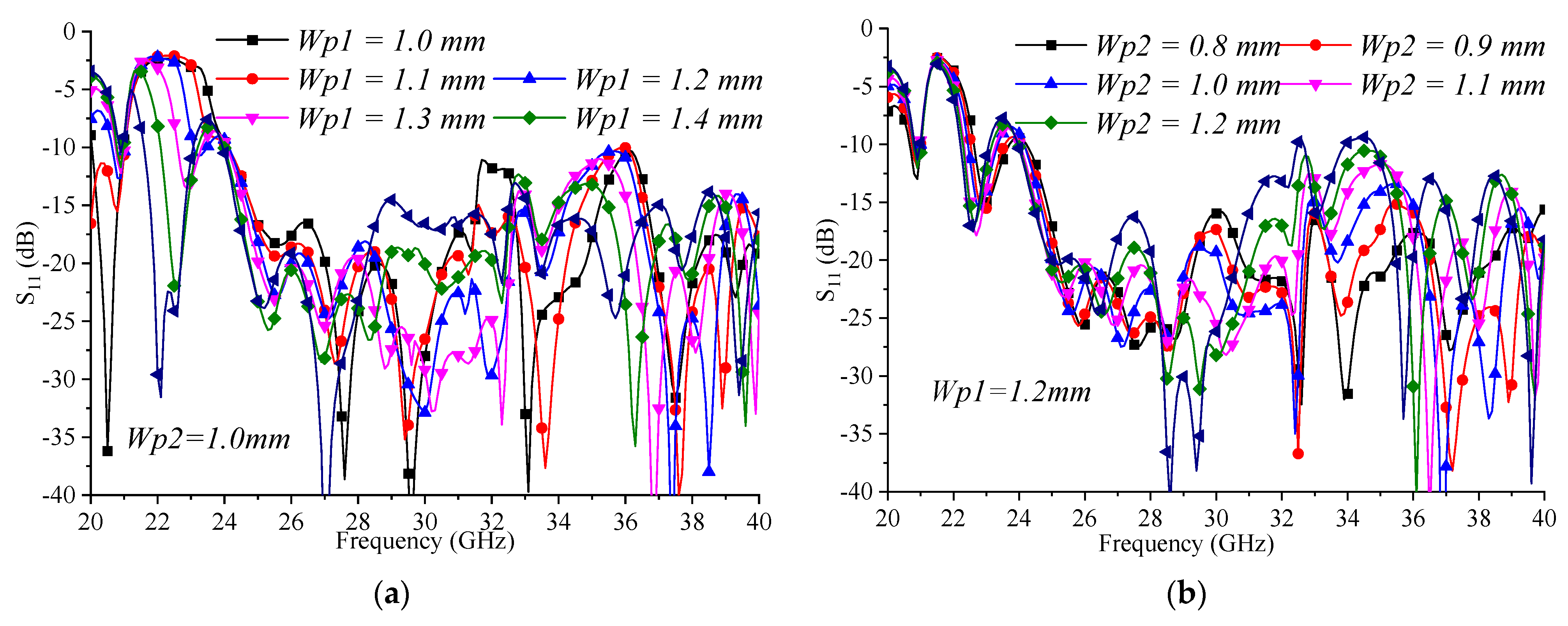



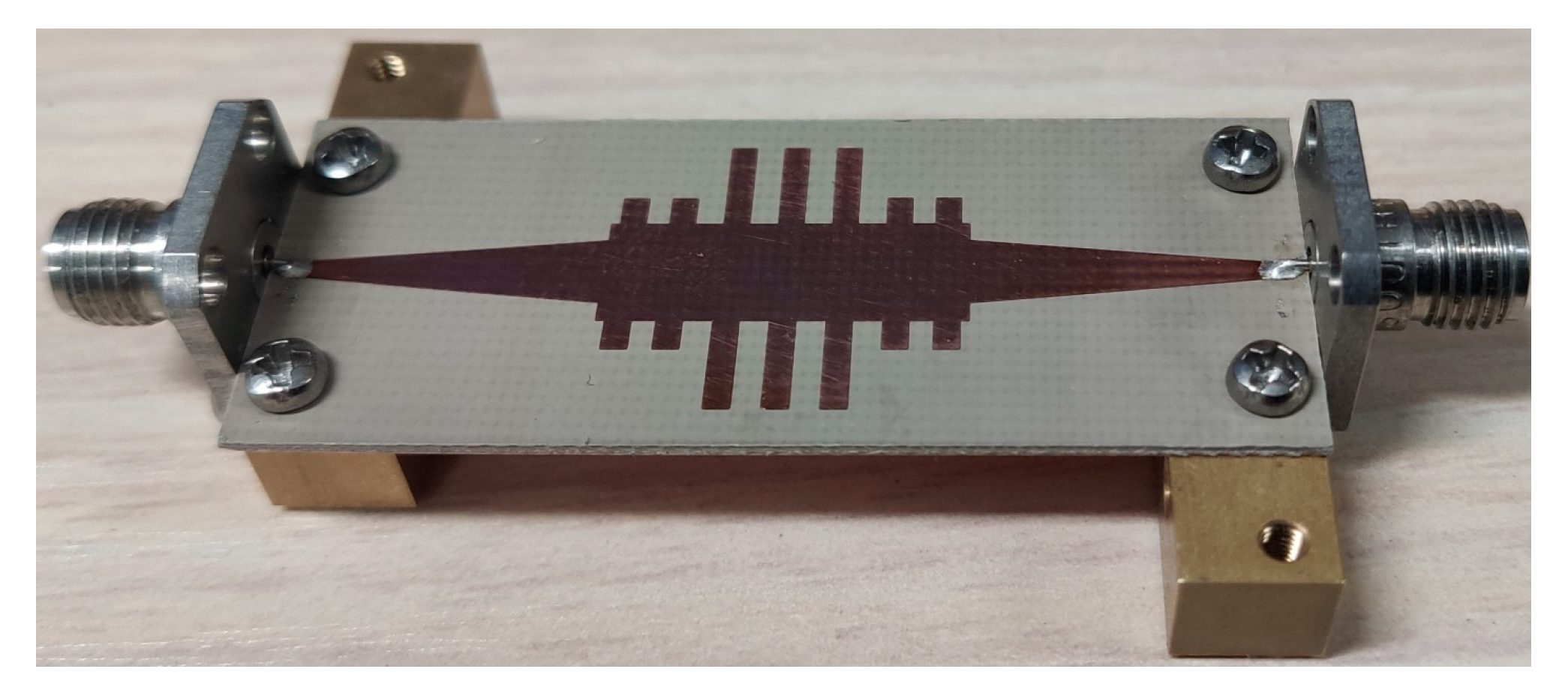
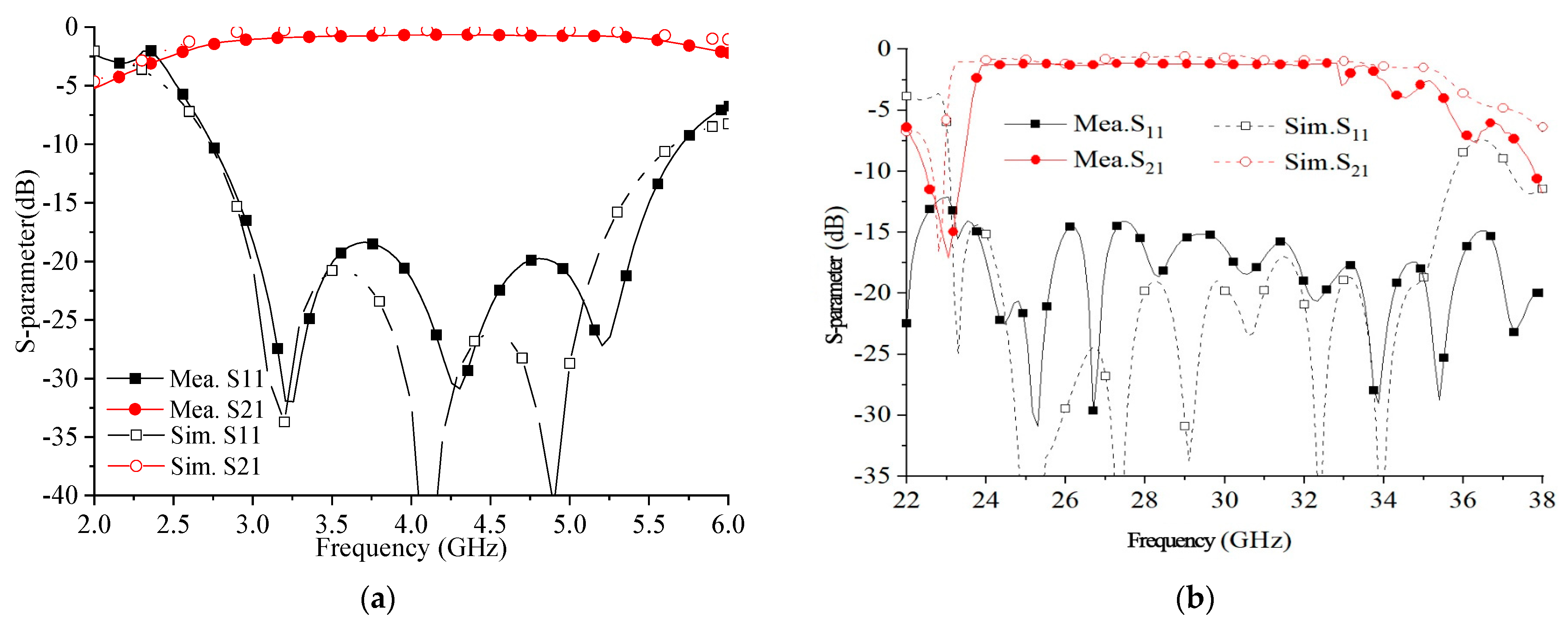

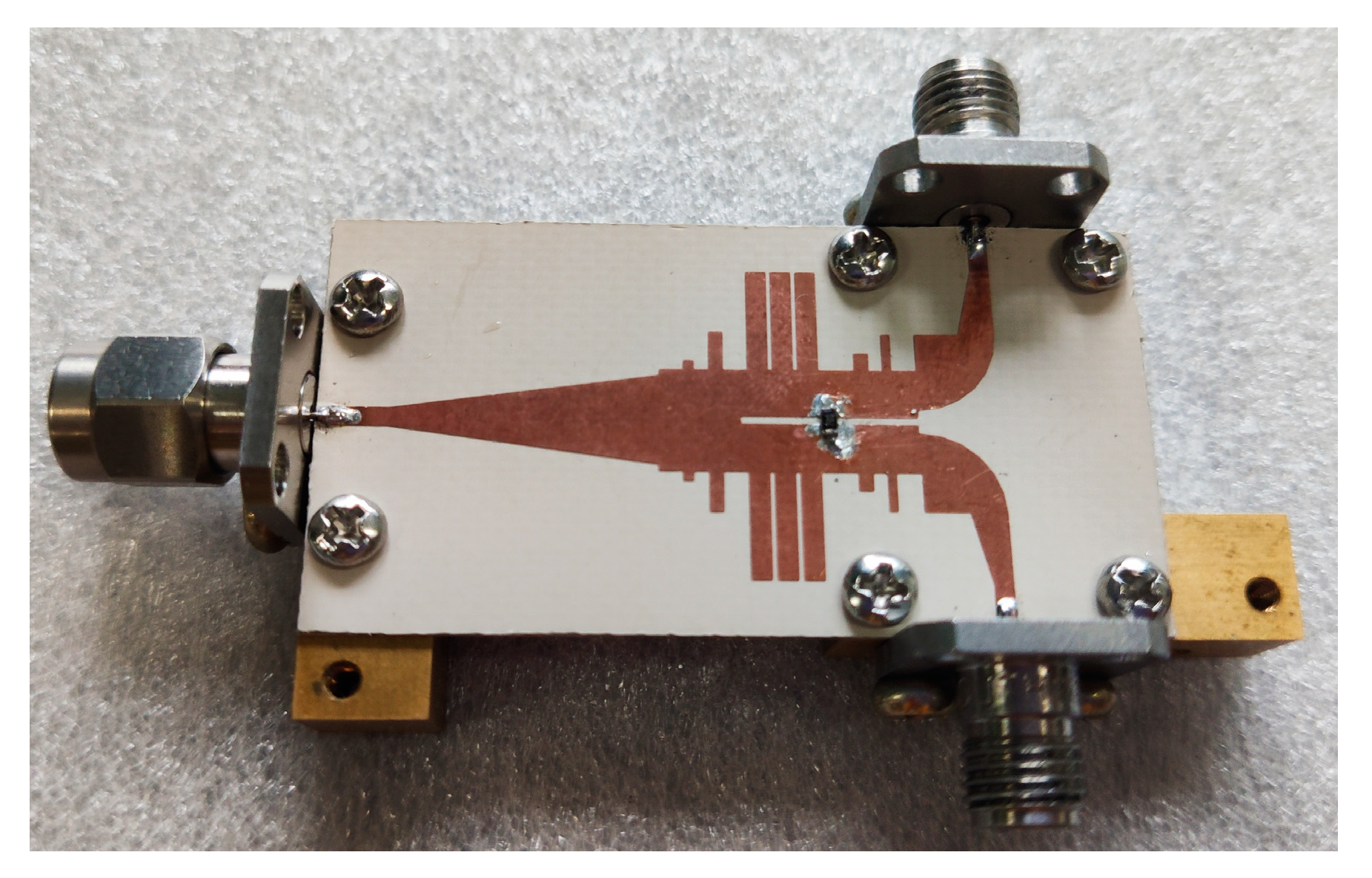
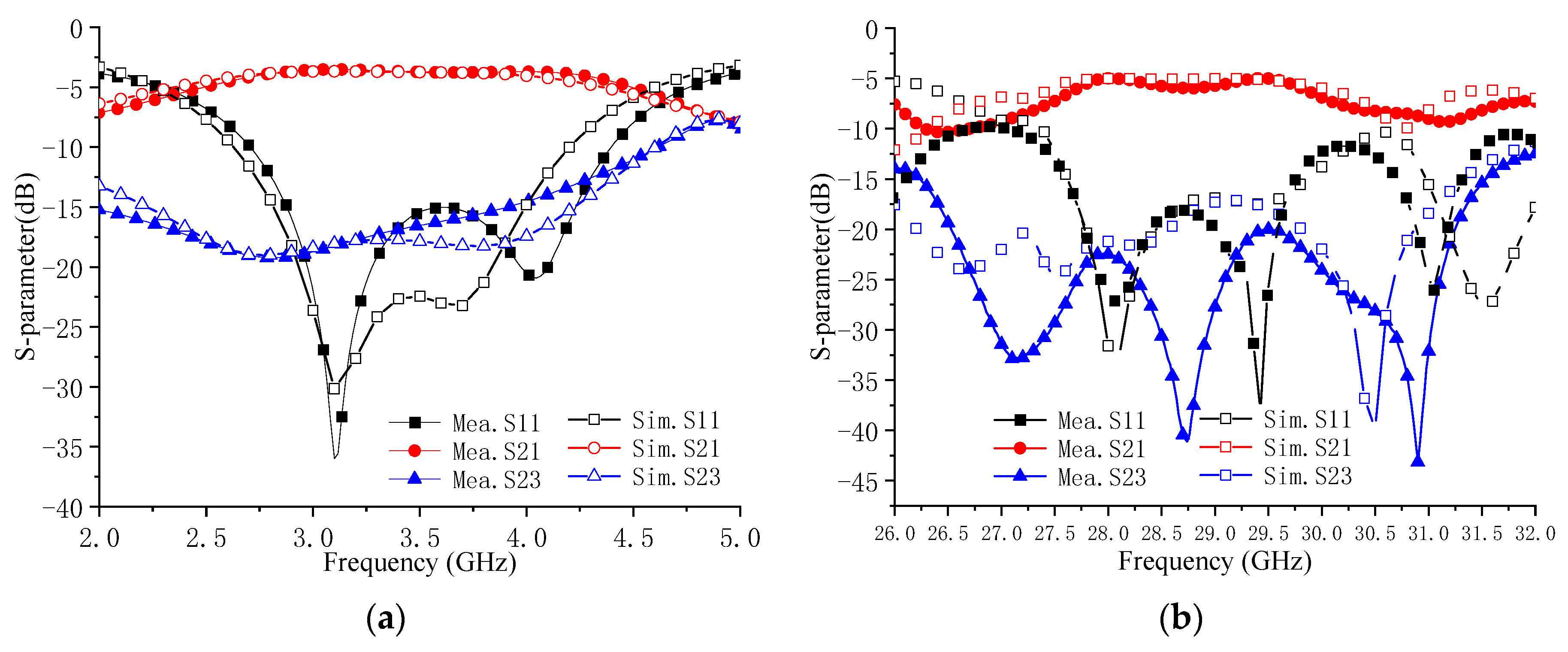
| a | Lp1 | Lp2 | Wp1 | Wp2 | d | H |
|---|---|---|---|---|---|---|
| 6 | 5 | 1.6 | 1.2 | 1.2 | 2.5 | 0.508 |
| Lm1 | Lm2 | Lm3 | Wm1 | Wm2 | W | t |
| 1.4 | 13.73 | 17.38 | 1.1 | 3.8 | 10 | 0.018 |
| Ref. | Transmission Line Type | Substrate Layer | Feeding Technique | Operating Frequencies (GHz) | |
|---|---|---|---|---|---|
| Low Band | High Band | ||||
| [5] | MCW | 3 | Joint feeding | 8–10.3 | 27–37 |
| [6] | DMCMS | 2 | Joint feeding | 3.5–12 | 35.6–41.6 |
| [7] | SIW-MS | 2 | IMS | 5–6.4 | 29.2–30.9 |
| [8] | SIW-CPW | 2 | Joint feeding | 3–10 | 25–40 |
| This work | SSPPs-CSIW | 1 | IMS | 2.95–5.5 | 23.7–32 |
| Lm1 | Lm2 | Lm3 | Lm4 | Wp1 | Wp2 | Wp3 | Wp4 | Wp5 | Lr |
|---|---|---|---|---|---|---|---|---|---|
| 4 | 14.8 | 14.3 | 3.93 | 0.64 | 0.83 | 1.2 | 0.86 | 0.54 | 5.5 |
| Lp1 | Lp2 | Lp3 | Lp4 | Lp5 | Wm1 | Wm2 | Wm3 | Ws | Ls |
| 0.55 | 2.28 | 6.0 | 1.03 | 2.17 | 1.1 | 5.26 | 2.06 | 0.39 | 9.72 |
| d1 | d2 | d3 | d4 | d5 | d6 | d7 | a | Rp | |
| 9.25 | 4.13 | 0.2 | 2.7 | 9 | 9.6 | 1.34 | 6.0 | 4.51 |
| Ref. | f1/f2 (GHz) | Frequency Ratio | Isolation (dB) A/B | Insertion Loss (dB) | Method |
|---|---|---|---|---|---|
| [26] | 0.98/1.98 | 2.02 | 14.8/16.7 | 0.6 | two-section impedance transformer |
| [27] | 2.46/3.54 | 1.44 | 18/22 | 1.4 | microstrip transition |
| [28] | 2.45/4.44 | 1.81 | 15/15 | 1.2 | novel dual-band resonator |
| [29] | 2.4/3.5 | 1.46 | \ | 0.6 | evanescent mode technique |
| [30] | 1.8/4.775 | 2.65 | 18/22 | 0.55 | dual-band Π-section transformation |
| [31] | 1.5/2.4 | 1.6 | 10/10 | 0.8 | double-sided parallel strip line |
| This work | 3.5/28.65 | 8.19 | 15/17 | 0.7 | MC-TL |
Disclaimer/Publisher’s Note: The statements, opinions and data contained in all publications are solely those of the individual author(s) and contributor(s) and not of MDPI and/or the editor(s). MDPI and/or the editor(s) disclaim responsibility for any injury to people or property resulting from any ideas, methods, instructions or products referred to in the content. |
© 2024 by the authors. Licensee MDPI, Basel, Switzerland. This article is an open access article distributed under the terms and conditions of the Creative Commons Attribution (CC BY) license (https://creativecommons.org/licenses/by/4.0/).
Share and Cite
Song, K.; Fang, L.; Zhou, Y. Dual-Band Large-Frequency Ratio Power Divider Using Mode Composite Transmission Line for 5G Communication Systems. J. Low Power Electron. Appl. 2024, 14, 20. https://doi.org/10.3390/jlpea14020020
Song K, Fang L, Zhou Y. Dual-Band Large-Frequency Ratio Power Divider Using Mode Composite Transmission Line for 5G Communication Systems. Journal of Low Power Electronics and Applications. 2024; 14(2):20. https://doi.org/10.3390/jlpea14020020
Chicago/Turabian StyleSong, Kaijun, Lele Fang, and Yedi Zhou. 2024. "Dual-Band Large-Frequency Ratio Power Divider Using Mode Composite Transmission Line for 5G Communication Systems" Journal of Low Power Electronics and Applications 14, no. 2: 20. https://doi.org/10.3390/jlpea14020020
APA StyleSong, K., Fang, L., & Zhou, Y. (2024). Dual-Band Large-Frequency Ratio Power Divider Using Mode Composite Transmission Line for 5G Communication Systems. Journal of Low Power Electronics and Applications, 14(2), 20. https://doi.org/10.3390/jlpea14020020






